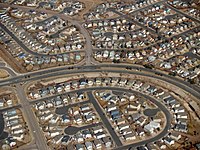
Photo from wikipedia
Running can improve physical health and psychological wellbeing. However, the characteristics of conducive running environments are relatively unknown. This study determines neighborhood factors that attract running and explores how age… Click to show full abstract
Running can improve physical health and psychological wellbeing. However, the characteristics of conducive running environments are relatively unknown. This study determines neighborhood factors that attract running and explores how age and gender mediate built environment preferences. Spatial patterns of runners in Metro Vancouver were identified using crowdsourced fitness data from Strava, a popular application for tracking physical activities. The influence of socio-economic status (SES), green and/or blue space, and urbanicity on route popularity was assessed using a Generalized Linear Model (GLM). The influence of these neighborhood variables was also calculated for runners by age and gender. The results show high neighborhood SES, the presence of green and/or blue space, and high population density are associated with increased running activities in all age and gender groups. This study contributes a novel approach to understanding conducive running environments by demonstrating the utility of crowdsourced data in combination with data about urban environments. The patterns of this large group of runners can be used to inform planning for cities that promote running, as well as seek to encourage equal participation among different ages and genders.
Journal Title: International Journal of Environmental Research and Public Health
Year Published: 2022
Link to full text (if available)
Share on Social Media: Sign Up to like & get
recommendations!